Cape Mentelle Vineyards
Cape Mentelle Vineyards (commonly referred to as Cape Mentelle) is a wine estate located in the Margaret River region, 274km south-west of Perth, Western Australia. The winery was founded by David Hohner, a third-generation farmer who studied wine making and viticulture in California in the 1960s and his brothers Mark and Giles.[1] Cape Mentelle is one of the ‘founding five’ wineries in Margaret River and is well known for producing Cabernet Sauvignon and Chardonnay in the region.[1] The winery was established in 1970 and came to prominence by winning the Jimmy Watson Memorial Trophy in both 1983 and 1984 for their Cabernet sauvignon.[1]
| Cape Mentelle Vineyards | |
|---|---|
 | |
| Location | 331 Wallcliffe Road, Margaret River, Western Australia 6285, Australia |
| Coordinates | 33°58′03″S 115°02′16″E |
| Wine region | Margaret River |
| Founded | 1970 |
| First vintage | 1976 |
| Parent company |
|
| Known for | Cape Mentelle Cabernet Sauvignon |
| Varietals | Chardonnay, Cabernet Sauvignon, Merlot, Sauvignon blanc, Semillon, Shiraz, Zinfandel |
| Distribution | International |
| Tasting | Open to public |
| Website | capementelle |
The Cape Mentelle cellar door is open for tasting every day from 10am to 5pm and is located at 331 Wallcliffe Rd, Margaret River WA 6285.[2] During the summer, the garden at Cape Mentelle becomes an outdoor cinema, offering both old and new films.[2] Local wine and food are made available with summer months being December through to March.[2]
History
The Margaret River wine region was first proposed by Agronomist Dr John Gladstone, who suggested season similarities to that of Bordeaux.[3] David capitalised on this discovery to start one of the ‘founding five’ wineries in the region.[3]
The winery is situated right next to oceanic Cape Mentelle, named by the ‘Baudin expedition’ which sailed the coastline of Western Australia in 1801,[4] The Cape was discovered and then named after French cartographer Francois-Simon Mentelle, who lived in Paris in the early 18th century.[4]
The winery was established and then named after Cape Mentelle by David Hohnen and his brothers Mark and Giles, planting the first vines in 1970.[4] The brothers planted the vines in 16 hectares, now known as the Wallcliffe Vineyard, renowned for producing their classic Cabernet.[4]
_1912-mentelle-007.jpg.webp)
David, Mark and Giles experimented in a rammed earth shed for six years until producing their first vintage of Cabernet sauvignon in 1976[5] The brothers worked with Tom Cullity, the founder of the first Margaret River winery Vasse Felix in 1967 to help produce their award-winning Cabernets of 1983 and 1984.[5]
In 1983 and 1984, Cape Mentelle won the Jimmy Watson Memorial Award for the best one-year old dry red wine, cementing their position as a primary wine maker in Australia.[5]
In 1990, Veuve Clicquot acquired 50 percent of the Cape Mentelle Vineyard, and then in 2000 took 100 percent ownership of the vineyard[6] In 2002 the present owners, LVMH group bought Veuve Clicquot and with it the Cape Mentelle Vineyards.[6]
In 2010, Cape Mentelle was the first winery in the Margaret River to attain the Entwine accreditation (total sustainable winegrowing Australia). This requires the winery to report annually and continue to minimise their impact on the surrounding environment.[7]
In 2020, Cape Mentelle had their 50-year anniversary and celebrated it by having Ocean Photographer Eugene Tan (Aquabumps) take photos of the Cape and vineyard to document the Margaret River’s 50th year as a wine region.[7] The photos were displayed at the North Bondi Surf Lifesaving Club.[2]
Geography
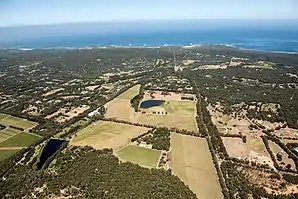
The Margaret River is positioned in the South West of Western Australia, 277 kilometres south of Perth. The river itself is located 9 kilometres inland from the Indian Ocean, with the area having an annual average rainfall of 1,130 millimetres. In the summer months the average day temperature is 26°C, whilst in the winter months the average day temperature is 17°C
This Mediterranean style climate, lacking extreme summer and winter temperatures, provides an ideal temperate climate for producing wine with minimal risk of flooding or frost.[3] With available water from Margaret River and adequate exposure to sunlight this area is able to produce great Cabernet and Chardonnay wines.[3]
The Margaret River region has undulating ironstone gravel soils, with Eucalyptus callophylla growing, which Gladstone indicated would yield prime vineyard soils.[3] The climate of the region suggests season parallels to Bordeaux, instructing the first houses to plant and produce classic cabernet and merlot wines.[3] This is what lead David and his brothers to plant and produce their award-winning Cabernet back in 1983 and 1984.
Wines
Cape Mentelle is renowned for crafting fine wines, particularly Cabernet Sauvignon, which contributed significantly to putting Margaret River on the global map and establishing the region's reputation in fine winemaking.
- Cabernet Sauvignon: The first wine variety produced by Cape Mentelle in the 1970s, released for public consumption in 1976. The 1983 and 1984 Cabernet vintages winning the Jimmy Watson Award for best one-year old red wine.[1]
- Shiraz
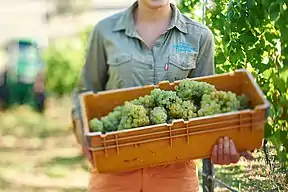 Harvest buckets full of Cape Mentelle grapes
Harvest buckets full of Cape Mentelle grapes - Cabernet Merlot
- Shiraz Cabernet
- Zinfandel
- Grenache
- Cabernet Merlot
- Cabernet Franc
- Cabernet franc
- Semillon
- Sauvignon Blanc Sémillon
- Rosé
Cape Mentelle is open for tasting every day from 10am to 5pm. The cellar door is located at 331 Wallcliffe Road, 4 kilometres south of Margaret River town centre. The Winery offers private tours and tastings for customers to better understand the wine making process.[8] During summer, the garden at Cape Mentelle becomes an outdoor cinema, offering both old and new films. Local wine and food are made available.[8]
Associated vineyards
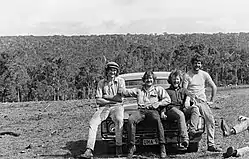
Cape Mentelle was one of the founding five wineries in the Margaret River region, along with Leeuwin Estate, Vasse Felix, Cullen Wines and Voyager Estate.[2] Vasse Felix was the first winery in the region, planting their first commercial grapes in the 1850s.[9] Vasse Felix planted three acres of vines to supply wines to significant numbers of American whalers who piled their trade off the coast of Western Australia.[9] Tom Cullity, a wine viticulturist in the region who started Vasse Felix helped David Hohnen and his brothers plant the first grapes at Cape Mentelle in 1970.[2]
Cloudy Bay Vineyard
The Cloudy Bay Vineyards were founded by David Hohnen in 1985, following the founding of the Cape Mentelle Vineyard.[10] The winery is situated in the Marlborough wine region of New Zealand, with vineyards in both Marlborough and Central Otago.The winery brought New Zealand Sauvignon Blanc to world-wide attention in the 1980s when its first vintages were reviewed by British wine writer Oz Clarke, who wrote that New Zealand Sauvignon Blanc is “arguably the best in the world”.[11] Cloudy Bay was an instrument in establishing New Zealand's international's reputation for white wine. Hohnen sold the winery to the Champagne house Veuve Cliquot in 2003 and is now part of the LVMH brand.[12]
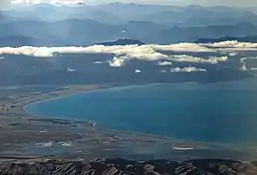
International Cabernet Tasting
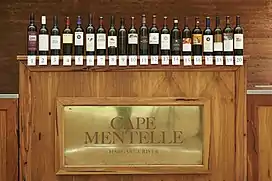
In 1982, Cape Mentelle hosted its first International Cabernet Tasting, which has since become an annual tradition at the Estate.
This extended blind tasting showcasing outstanding Cabernet from around the world continues to attract some of the most influential people in the field, bringing together experts, journalists and wine aficionados.
The guided tasting is followed by a catered pairing lunch with local ingredients from Margaret River.
References
Notes
- Halliday, J., 2007. Wine atlas of Australia. Univ of California Press
- Sweeney, D., 2020. River to Cape. Gourmet Traveller Wine, 14 February, p.4.
- Tile, P.J., Stuart-Street, A. and Gardiner, P.S., 2020. Geology, soils and climate of the Margaret River wine region.
- Alonso, A.D. and Northcote, J., 2009. Wine, history, landscape: origin branding in Western Australia. British Food Journal.
- Halliday, J., 2019. Cape Mentelle’s wheel of fortune. The Australian Newspaper, 13 December, p.6.
- Jordan, Ray (2002). Wine: Western Australia's Best. Osborne Park, WA: The West Australian pp. 50–99.
- Ball, J. and Stolle, M., 2019. Cellar doors: The impact of cellar doors: Design, experiences, and maximising customer relationships. Wine & Viticulture Journal, 34(4), p.60.
- Scott, Jane; Negus, Patricia 2011. Stories from the Cellar Door: Fifty Margaret River Wineries Tell Their Tales. North Fremantle, WA: Cape to Cape Publishing. pp. 26–27, 106–110.
- Taber, George (2005). Judgment of Paris: California vs France and the Historic 1976 Paris Tasting that Revolutionized Wine. New York: Scribner. pp. 243. ISBN 978-0-74-324751-1.
- Campbell, Bob (30 July 2003). "Founder of Cloudy Bay and Cape Mentelle Steps Down". Wine Spectator. Retrieved 4 June 2020.
- Rachman, Gideon (16 December 1999). "The globe in a glass". The Economist.
- Bell, Cathie (14 April 2014). "Cloudy Bay in Central Otago deal". Marlborough Express. Retrieved 25 May 2020 – via Stuff.
Bibliography
- Halliday, James (1985). The Australian Wine Compendium. North Ryde, NSW: Angus & Robertson. pp. 473–477, 490–507. ISBN 0207151377.
- Halliday, James (2008). James Halliday's Wine Atlas of Australia (rev. ed.). Prahran, Vic: Hardie Grant Books. pp. 234–239. ISBN 9781740666855.
- Jordan, Ray (2002). Wine: Western Australia's Best. Osborne Park, WA: The West Australian. pp. 50–99. ISBN 0909699887.
- Scott, Jane; Negus, Patricia (2011). Stories from the Cellar Door: Fifty Margaret River Wineries Tell Their Tales. North Fremantle, WA: Cape to Cape Publishing. pp. 26–27, 106–110. ISBN 9780980333763.
- Wiltshire, Trea (2000). Margaret River. Australian Wine Regions series. Singapore: R. Ian Lloyd Productions. ISBN 9810426747.
- Zekulich, Michael (2000). Wine Western Australia (all new ed.). Perth: St George Books. pp. 122–235. ISBN 0867780614.